| Page last updated
22 February 2013 |
Freshwater (and not-so-freshwater) Bivalves of the World
Twenty-one families of bivalves have been attributed to fresh waters. However, 1) only eight of these have really radiated into in-land habitats, 2) five are really restricted to brackish marine waters, and 3) the rest are something in between.
The line dividing the freshwater bivalves and the marine bivalves is fuzzy. Those taxa that are strictly freshwater occupy in-land habitats above sea level. That is, they occur above tidal influences and are capable of living and reproducing in waters with <5 parts per thousand (ppt) dissoved salts. The strictly marine bivalves are more comfortable at 35 ppt, away from all freshwater inputs. While some bivalve families typically inhabit the oligohaline no-clams-land between these environments, a few families are able to stradle these extremes.
The table below is taken from the following paper:
- Graf, D.L. 2013. Patterns of freshwater bivalve global diversity and the state of phylogenetic studies on the Unionoida, Sphaeriidae, and Cyrenidae. American Malacological Bulletin 31: 135-153.
The twenty-one bivalve families listed are the ones that have been attributed to "fresh waters" over the years (see Graf, 2013 for a review of the literature). We divide those 21 families into three groups. Five of these families occur only in brackish waters. From the perspective of the marine environment, those five families (Cyrenoididae, Solenidae, Mactridae, Erodonidae, and Teredinidae) have representatives that occur in "freshened" near-shore environments. These are not freshwater bivalves, and they simply represent marine lineages that tolerate brackish waters. They are labeled as such in the table.
The families in bold are the eight primary freshwater families: Unionidae, Margaritiferidae, Hyriidae, Etheriidae, Mycetopodidae, Iridinidae (all order Unionoida, the freshwater mussels), Sphaeriidae, and Cyrenidae (latter two, order Veneroida). Among these families, only the Cyrenidae (= Corbiculidae) has any brackish/marine representatives. Otherwise, the primary freshwater families represent at least four separate radiations into freshwater habitats.
The remaining eight families are the secondary freshwater families: Mytilidae, Arcidae, Cardiidae, Dreissenidae, Donacidae, Pharidae, Corbulidae, and Pholadidae. These families are typically brackish/marine but with at least one bona fide species living in freshwater habitats.
The table tallies the species richness in fresh waters for each family, globally as well as among the continental provinces. Numbers in parentheses represent introduced species. These data were last updated 22 February 2013.
| Taxon |
total |
Nearctic |
Neotropical |
Afrotropical |
Palearctic |
Indotropical |
Oceania/
Australasia |
|
| Mytilidae |
5 |
0 |
(1) |
0 |
(1) |
5 |
0 |
| Arcidae |
5 |
0 |
0 |
0 |
0 |
5 |
0 |
| Unionidae |
681 |
295(1) |
94 |
38 |
46(1) |
218 |
2 |
| Margaritiferidae |
13 |
5 |
0 |
0 |
8 |
1 |
0 |
| Hyriidae |
75 |
0 |
44 |
0 |
0 |
0 |
31 |
| Etheriidae |
4 |
0 |
2 |
1 |
0 |
1 |
0 |
| Mycetopodidae |
43 |
0 |
43 |
0 |
0 |
0 |
0 |
| Iridinidae |
43 |
0 |
0 |
43 |
0 |
0 |
0 |
| Cardiidae |
3 |
0 |
0 |
0 |
3 |
0 |
0 |
| Cyrenidae |
92 |
(1) |
4(3) |
4 |
13(1) |
72 |
2(1) |
| Cyrenoididae |
brackish |
| Dreissenidae |
9 |
2(2) |
3 |
0 |
5(1) |
0 |
0 |
| Sphaeriidae |
227 |
41 |
59 |
33 |
54 |
29 |
27 |
| Donacidae |
2 |
0 |
0 |
2 |
0 |
0 |
0 |
| Solenidae |
brackish |
| Pharidae |
5 |
0 |
0 |
0 |
0 |
5 |
0 |
| Mactridae |
brackish |
| Corbulidae |
1 |
0 |
1 |
0 |
0 |
0 |
0 |
| Erodonidae |
brackish |
| Teredinidae |
brackish |
| Pholadidae |
1 |
0 |
0 |
0 |
0 |
1 |
0 |
|
| TOTAL |
1209 |
347 |
254 |
121 |
133 |
337 |
62 |
| 1° freshwater |
1178 |
343 |
249 |
119 |
123 |
321 |
62 |
| 2° freshwater |
31 |
4 |
5 |
2 |
10 |
16 |
0 |
More than 97% (1178/1209) of freshwater bivalves belong to the primary freshwater families. The hotspots of freshwater bivalve diversity are the Nearctic and Indotropical provinces (and to a lesser extent the Neotropics). The Nearctic assemblage is dominated by the Unionidae, with species richness concentrated in the southeastern United States. The Indotropics are also inhabited by many unionid species in addition to an extensive radiation by the Cyrenidae.
The two areas with the most secondary freshwater families are the Palearctic and Indotropics.
The following list of freshwater (and not-so-freshwater) bivalves is taken from the appendix of Graf (2013). That article provides references and a bibliography.
Family MYTILIDAE |
| † |
Brachidontes arcuatulus — Distribution: Indochina. Brachidontes is a typically marine/intertidal genus with >30 species. |
| † |
Limnoperna fortunei = L. siamensis = L. supoti = L. coreana — Distribution: southeastern Asia; introduced to Brazil, Japan, etc. Limnoperna is a typically brackish water genus of 9 species.
L. securis = Xenostrobus securis. — Distribution: brackish, Australia and New Zealand; introduced to Japan.
Mytella charruana — Distribution: brackish, Neotropical; introduced to Florida. Mytella is a typically marine/intertidal genus of 5 species.
M. maracaibensis — Distribution: brackish, Lake Maracaibo.
|
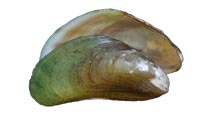
Limnoperna (Mytilidae) |
|
| † |
Sinomytilus harmandi — Distribution: Mekong Basin. Sinomytilus is a poorly known, exclusively freshwater genus. |
| † |
S. morrisoni — Distribution: Mun River (Mekong). |
| † |
S. swinhoei — Distribution: Yangtze River. |
Family ARCIDAE
|
| † |
Scaphula celox — Distribution: lower Ganga Basin. Scaphula is a freshwater genus in a typically marine family. |
| † |
S. deltae — Distribution: lower Ganga Basin. |
| † |
S. minuta — Distribution: eastern Thailand peninsula. |
| † |
S. nagarjunai — Distribution: Krishna River, India. |
| † |
S. pinna — Distribution: Burma & Thailand. |
Order UNIONOIDA
There are six families of freshwater mussels. All unionoids are restricted to freshwater habitats. The MUSSELp Database provides a detailed assessment of taxonomic and geographical patterns of species richness.
Family CARDIIDAE
The Limnocardiinae occurs in Ponto-Caspian brackish/marine waters. A few species are found in waters of low salinity (< 5 ppt). |
| † |
Adacna laeviuscula = A. fragilis — Distribution: fresh/brackish, Black & Caspian Seas. |
| |
A. vitrea = A. glabra = A. minima = A. sidorovi — Distribution: brackish, Caspian & Aral Seas. |
| |
Didacna (8 species). — Distribution: brackish, Caspian Sea. |
| † |
Hypanis plicata = H. relicta = H. regularis — Distribution: fresh/brackish waters of the Black and Caspian Seas. The two other species of Hypanis are strictly brackish. |
| † |
Monodacna colorata — Distribution: rivers and reservoirs, Black Sea Basin. Monodacna is a typically brackish genus of 8 species. |
|
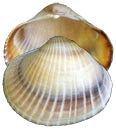
Monodacna (Cardiidae) |
Family CYRENIDAE = CORBICULIDAE
The Cyrenidae is unique among the primary radiations of freshwater bivalves in that the family is composed of a mix of marine/brackish and freshwater species. |
| † |
Corbicula (88 species). — Distribution: mostly freshwater, temperate/tropical Asia and Africa, widely introduced. |
| |
Batissa (3 species), Villorita (3 species), and Geloina (3 species). — Distribution: brackish, Indo-Pacific. |
| † |
Neocorbicula (4+ species). — Distribution: Central and South America. The diversity of Neocorbicula is likely under-estimated. |
| |
Polymesoda (17 species). — Distribution: brackish, tropical eastern Pacific, western Atlantic. |
Family CYRENOIDIDAE |
| |
Cyrenoida (6 species). — Distribution: brackish, tropical Americas, West Africa. |

Cyrenoida
(Cyrenoididae) |

Dreissena
(Dreissenidae) |

Mytilopsis
(Dreissenidae) |
Family DREISSENIDAE |
| † |
Congeria kusceri — Distribution: subterranean, Balkins. |
| † |
Dreissena bugensis — Distribution: rivers & estuaries in the Black Sea Basin; introduced to North America. Dreissena is a fresh and brackish water genus of 7 species. |
| † |
D. caputlacus — Distribution: Tigris-Euphrates. |
| † |
D. carinata — Distribution: Lake Ohrid. |
| † |
D. polymorpha — Distribution: Europe; introduced to North America. |
| † |
Mytilopsis leucophaeata — Distribution: brackish and freshwater, Gulf of Mexico, Atlantic USA; introduced to Europe. Mytilopsis is a fresh and brackish water genus of 6 species. |
| † |
M. lopesi — Distribution: Amazon Basin. |
| † |
M. sallei — Distribution: Caribbean, South America. |
| † |
M. trautwineana — Distribution: Pacific South America; introduced to Caribbean. |
Family SPHAERIIDAE
The Sphaeriidae is strictly freshwater. |
| † |
Eupera (34 species) — Distribution: tropical Americas and Africa. |
| † |
Byassanodonta paranensis — Distribution: Parana Basin, South America. |
| † |
Pisidium (133 species) — Distribution: global. |
| † |
Sphaerium = Musculium (59 species) — Distribution: global. |
Family DONACIDAE |
| |
Galatea = Egeria (11 species) — Distribution: brackish, eastern Atlantic, West Africa. |
| † |
Iphigenia centralis — Distribution: Niger River. Iphigenia is a typically brackish water genus of 7 species. |
| † |
I. laevigata — Distribution: lower segments of rivers, Senegal to Congo. |
Family SOLENIDAE |
| |
Neosolen aquaedulcioris =? Solen delesserti. — Distribution: brackish, Indo-Pacific. Neosolen is regarded as a monotypic brackish water genus). |
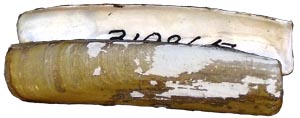
Neosolen (Solenidae) |

Novaculina (Phariidae) |
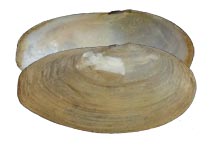
Pharella (Phariidae) |
Family CORBULIDAE
|
| † |
Anticorbula fluviatilis = Guianadesma sinuosum — Distribution: Amazon Basin. |
| |
Potamocorbula amurensis — Distribution: brackish, northwestern Pacific; introduced to San Francisco Bay. Potamocorbula is a brackish/marine genus of 9 species. |
Family ERODONIDAE |
| |
Erodona mactroides — Distribution: brackish, temperate southwestern Atlantic estuaries. |
Family TEREDINIDAE
|
| |
Nausitora dunlopei — Distribution: brackish, Indo-Pacific. Nausitora is a brackish/marine genus of 6 species. |
| |
Psiloteredo healdi — Distribution: brackish, Caribbean, Lake Maracaibo. Psiloteredo is a brackish/marine genus of 3 species. |
|
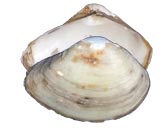
Erodona (Erodonidae) |
Family PHOLADIDAE |
| † |
Lignopholas fluminalis — Distribution: India, Burma and Borneo. Lignopholas is a typically brackish/marine genus of 4 species. |
|